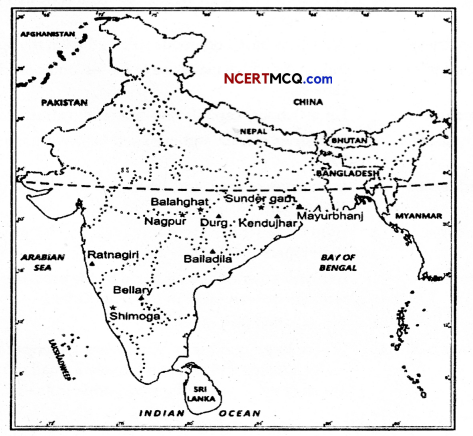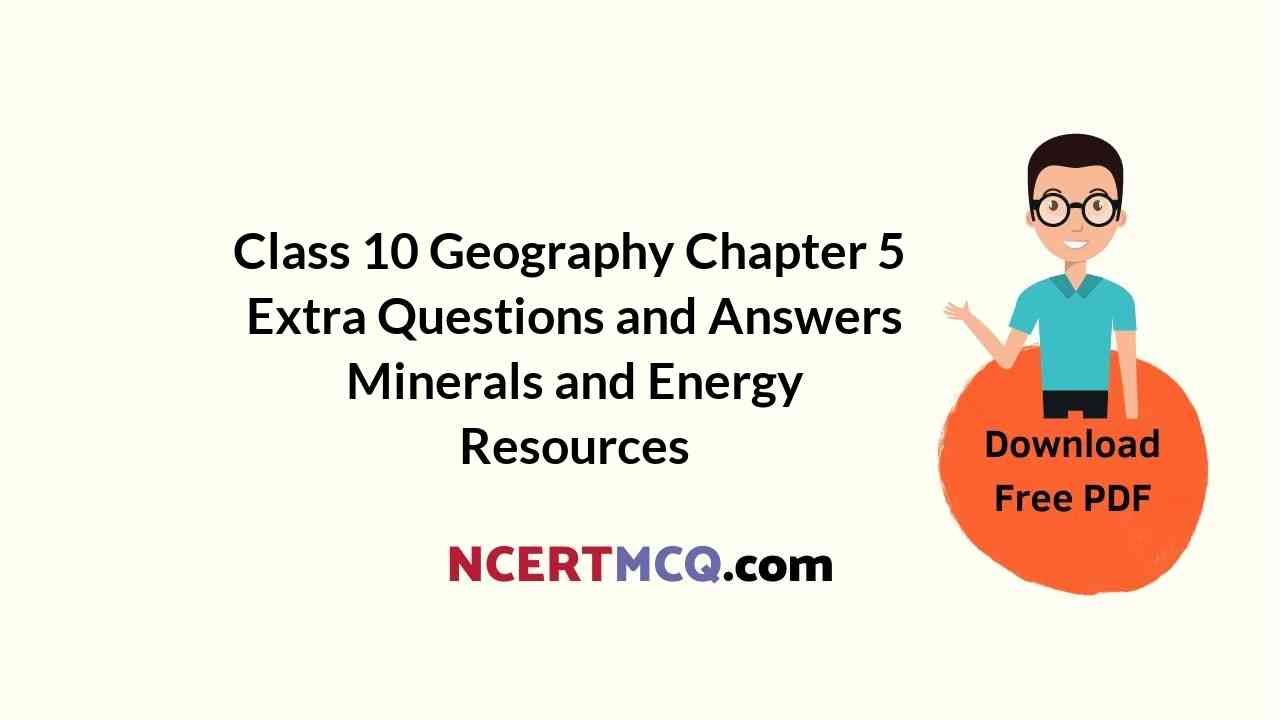Check the below NCERT MCQ Questions for Class 10 Geography Chapter 5 Extra Questions and Answers Minerals and Energy Resources with Answers Pdf free download. https://ncertmcq.com/extra-questions-for-class-10-social-science/
Minerals and Energy Resources Class 10 Extra Questions Geography Chapter 5
Class 10 Geography Chapter 5 Extra Questions Question 1.
When did the Energy Conservation Act in India come into effect?
Answer:
In March 2002.
Minerals And Energy Resources Class 10 Extra Questions And Answers Question 2.
How much wind power potential does India have?
Answer:
About 20,000 MW.
Minerals And Energy Resources Class 10 Important Questions Question 3.
Where is the largest solar plant of India located?
Answer:
In Madhapur near Bhuj.
Minerals And Energy Resources Class 10 Extra Questions Question 4.
What is the non-conventional energy potential of India?
Answer:
Trie non-conventional energy potential of India is estimated at about 95,000 MW.
![]()
Extra Questions For Class 10 Geography Chapter 5 Question 5.
How much electricity is generated from nuclear plants?
Answer:
The gross electricity generated from nuclear plants is 2720 MW per day.
Geography Chapter 5 Class 10 Questions And Answers Question 6.
How many thermal power plants does India have?
Answer:
India has more than 310 thermal power plants.
Class 10 Geography Chapter 5 Question Answer Question 7.
What is the share of thermal electricity in India?
Answer:
The share of thermal electricity in India is about 70%.
Class 10 Geography Chapter 5 Important Questions Question 8.
What is the share of hydroelectricity in our country?
Answer:
Hydroelectricity accounts for 25% of the total electricity.
Minerals And Energy Resources Extra Questions Question 9.
What is the total hydel power potential of India?
Answer:
Total hydel power potential for India is estimated at 150,000 MW.
Class 10 Geography Chapter 5 Extra Questions And Answers Question 10.
How much of the total hydel power potential has already been developed?
Answer:
Only one-sixth.
Class 10 Geography Chapter 5 Questions And Answers Question 11.
Differentiate between thermal power and hydel power.
Answer:
Thermal Power
1. It is generated by using coal, petroleum and natural gas.
2. This type is power is not eco-friendly
3. Thermal power cannot be the permanent source of electricity as the sources of generating this type of power are limited and are showing signs of exhaustion.
Hydel Power
1. It is generated from turbines which run by the use of running water.
2. This type of power is comparatively eco-friendly.
3. This can be the source of electricity supply because water is a non-exhaustible resource because 2/3 of our earth is covered by water.
![]()
Minerals And Power Resources Extra Questions Question 12.
Point out the importance of natural gas.
Answer:
- Natural gas has been proved a very convenient source of energy.
- The use of natural gas in cooking has saved a huge quantity of coal and wood and has saved out world from pollution to a large extent.
- Natural gas-based power plants save much time and expenditure.
- Natural gas-based power plants save much time and expenditure.
- Natural gas can be used as an industrial raw material in petrochemical industry.
Minerals And Energy Resources Class 10 Questions And Answers Question 13.
Point out the reason why the annual production of gold has been dwindling in India?
Answer:
The annual production of gold has been dwindling in India because of the following reasons-
- The reserve of gold are in fact very small.
- Gold mines are very deep in India. Hence it is quite difficult to extract gold from them.
- The mining of gold has been in progress in India for a long time.
- Hence much of the gold ore has already been exhausted and there is very little ore to be mined.
Minerals And Energy Resources Class 10 Map Work Question 14.
Point out the importance of Neyveli Lignite fields.
Answer:
- Neyveli Lignite fields are in Tamil Nadu. These have been just like a boon for the state.
- Thermal power produced from the lignite coal of Neyveli fields has proved very useful for the industrialization of Tamil Nadu.
Extra Questions Of Mineral And Power Resources Question 15.
Explain the reasons why solar energy in Rajasthan and Biogas in the Northern plains have greater potential as non-conventional energy?
Answer:
The solar energy in Rajasthan and Biogas in the Northern plains gets more importance because of the geographical characteristics of these places. For example-
- In Rajasthan, it gets unperturbed sunshine for the most part of the year.
- In Northern India, animal waste is abundantly available hence biogas is more easily prepared here.
- These parts of India are climate-wise very appropriate for the biogas production.
Question 16.
“As compared to coal and mineral oil, hydroelectricity is a key source of energy.” Explain.
Or
Which is the best source of energy among coal, mineral oil and hydroelectricity? Give your point of view.
Answer:
Coal and mineral oil have been considered as the main source of power supply for a long time. The industrial developed countries have always used them as the main source of power supply. On the other hand, countries with limited reserves of these resources were forced to import these.
Because of all these facts, the world reserves of these minerals have begun to show the signs of exhaustion. In the teeth of fear of their exhaustion, some new sources of power supply had been invented and developed.
Hydel power is one such source. Hydel power has become more important nowadays in comparison to both coal and mineral oil. Because of this fact, every effort is being made to convert it into a permanent source of power supply. For this purpose, many large dams are being raised to maintain a constant supply of water to produce electricity.
That is why the hydel power has been developed mostly in both the developing and developed countries especially by those countries which posses limited or no coal reserves. Hydel power in comparison to coal and mineral oil is cheaper as well as pollution-free. It also provides advantages to hydel power in comparison to coal and mineral oil.
![]()
Question 17.
Give an account of the various uses of petroleum and the potential petroleum reserves in India.
Or
Write short notes on the following points-
1. Potential of the areas of the mineral oil deposits,
2. Production trend of mineral oil in India.
3. Increased demand and growth of mineral oil in India.
Answer:
Petroleum is the only multipurpose fuel of today’s world. It is also the most important source as thermal energy and motive power. In the recent years, the consumption, production, import and export of the mineral oil has assumed a wide scope especially for the developing countries like India. The uses of petroleum and petroleum resources is getting more and more importance every day.
Potential of the areas of the mineral oil deposits: The potential oil-bearing areas of deposits in India are tentatively estimated to be over one million square km. It covers Assam, the northern plains, the coastal strips, Gujarat, desert area, Thar, southern areas, Andaman and Nicobar islands and offshore sea.
The most important oil fields which are already serving the nation are located at Digboi, Naharkatiya, Moran, Ankleshwar, Cambay, Bombay-High, Kalol etc. Gas reserves are generally found in association with oil fields. However, there are certain other areas which are exclusively known for gas reserves. These areas are located in Tripura, Rajasthan, Offshore oil fields of Gujarat, Maharashtra, Tamil Nadu, Andhra Pradesh and Orissa.
Production trend of mineral oil in India : Before independence, Assam was the only state drilling and refining mineral oil. After independence, various new fields were found elsewhere in India like Gujarat, Bombay-High etc. India continued developing its technology and investing new areas. As a result, the production in the field of oil and natural gas has shown a continuous upward trend.
Increased demand and growth: Though India is producing more and more oil yet production of mineral oil in India is much less than the need of the country. In fact because of the development in every field and sector, the demand for mineral oil is increasing day by day. To fulfill its demand India is importing it. It is putting a great burden on our foreign exchange reserves. Hence India must find out alternative options.
Refining industries in India: Before its independence, India had only one oil refinery at Digboi in Assam. However today India has 8 refineries. All of these are helping India to fulfil its needs to a great extent, The refining capacity of these refineries is about 112.52 million tonnes a year. However, about 50 million tonnes of petroleum and petroleum products are being imported today.
Multiple Choice Questions
Question 1.
The following region produces more than 50% of the country’s copper:
(a) Balaghat
(b) Khetri
(c) Katni
(d) Nellore.
Answer:
(a) Balaghat
Question 2.
One of the following is not the major mica producing area:
(a) Ajmer
(b) Nellore
(c) Koderma
(d) Balaghat.
Answer:
(d) Balaghat.
Question 3.
The following is the low-grade coal:
(a) Bituminous
(b) Anthracite
(c) Lignite
(d) None of these.
Answer:
(c) Lignite
![]()
Question 4.
Naharkatiya is in the following state:
(a) Madhya Pradesh
(b) Assam
(c) Maharashtra
(d) Tamil Nadu.
Answer:
(b) Assam
Question 5.
Uranium and thorium are available in:
(a) Punjab
(b) Haryana
(c) Jharkhand
(d) West-Bengal
Answer:
(b) Haryana
Map Skills
Question 1.
Show the main minerals produced in India on the outline map of India.
Answer:
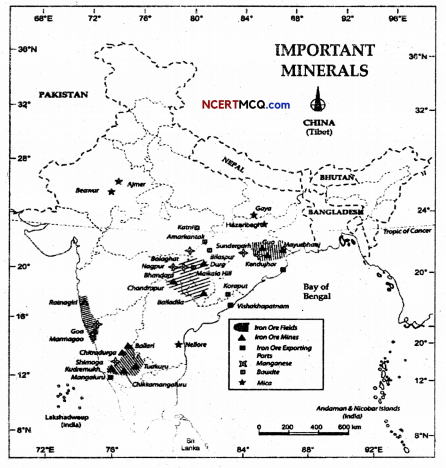
Question 2.
On the outline map of India. show the following:
(a) Iron ore belt
(b) Iron ore mines,
(c) Exporting ports.
Answer:
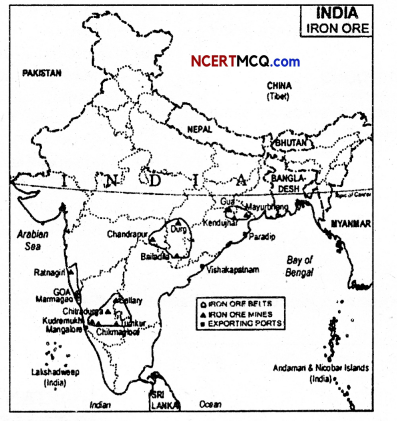
![]()
Question 3.
On the outline map of India, show the following:
(a) Mica belts,
(b) Manganese ore area
(c) Bauxite area,
(d) Mica area.
Answer:
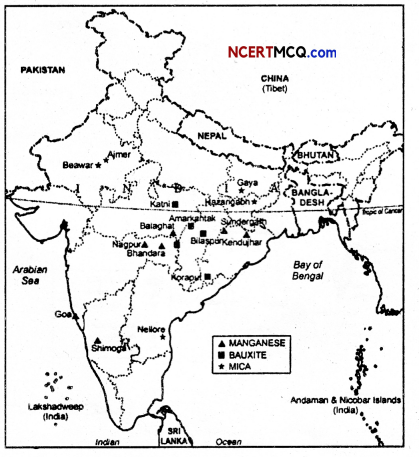
Question 4.
On the outline map of India, show the following:
(a) Nuclear Plants
(b) Thermal Plants
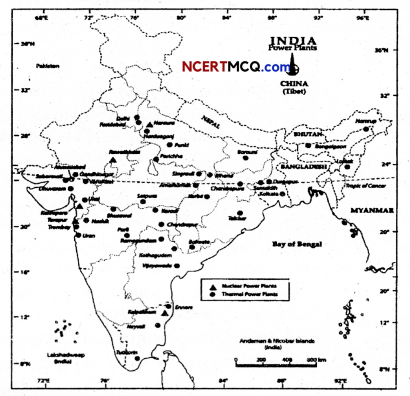
Question 5.
On the outline map of India, show the following:
(a) Coal mines
(b) Oil Fields
(c) Major Natural Gas Reserves
(d) Natural Gas Pipelines
Answer:
